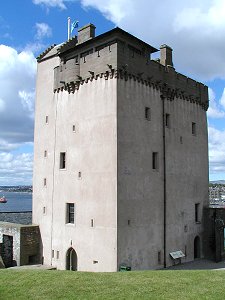
Braughty Castle was built by the Gray family
who were to own and occupy it until 1666
Clan Gray
The surname is originally French, being first borne by Fulbert, Great Chamberlain of Robert, Duke of Normandy, who granted him the castle and lands of Croy or Gray in Picardy which he thereafter assumed as the family surname. His daughter, Arlotta, is said to have been the mother of William the Conqueror. In England several families from this source were raised to high rank, and spelt their name ‘Grey’.
Like many others, the Grays swore fealty to Edward I of England in the Ragman Roll of 1296, but they were soon following Robert the Bruce on the long fight for Scottish independence. Sir Andrew Gray was one of the first to scale the rock of Edinburgh Castle when it was taken from the English in 1312. He was rewarded with several grants of land, including Longforgen in Perthshire, for his services to the Crown.
One of his descendants, another Sir Andrew, was one of the Scottish nobles who met James I at Durham from his return from captivity in England. He was created Lord Gray in 1444. Patrick, Master of Gray, son of the second Lord Gray, was a Gentleman of the Bedchamber to James II, and when the king stabbed the Earl of Douglas, Gray struck the next blow with a battleaxe. His son, the third Lord Gray, became Lord Justice General of Scotland in 1506. Patrick Gray of Butter-gask, the fifth Lord, was taken prisoner at the Battle of Solway Moss in 1542, and was ransomed for £500 sterling. He was one of the first promoters of the Reformation in Scotland, and in 1567 joined in the defence of the infant James VI.
- A1. Richard de Grey, Governer of Channel Islands;
<== de Grey family of England
- B1. Hugh de Grey;
- C1. John Grey;
- D1. David Grey;
- E1. John Gray;
- F1. Sir Andrew Gray of Broxmouth, lvd:1314, m. Ada Gifford;
- G1. Sir John Gray of Broxmouth;
- H1. Sir Patrcik Gray of Broxmouth, lvd:1373;
- I1. Margaret Gray, m. William Hay; <== Clan Hay
- I2. Sir Andrew Gray of Broxmouth, m. Janet Mortimer;
==> Mortimer family
- J1. Sir Andrew, 1st Lord Gray, lvd:1390/1469, m. Elisabeth Wemyss;
<========
- J1. Sir Andrew, 1st Lord Gray, lvd:1390/1469, m. Elisabeth Wemyss;
- H1. Sir Patrcik Gray of Broxmouth, lvd:1373;
- G1. Sir John Gray of Broxmouth;
- F1. Sir Andrew Gray of Broxmouth, lvd:1314, m. Ada Gifford;
- E1. John Gray;
- K1. Patrick Gray, lvd:1420/1463, m. Annabella Forbes;
==> Clan Forbes
- L1. Elizabeth Gray, m. David Rollo; <== Clan Rollo
- L2. Sir Andrew, 2nd Lord Gray, lvd:1445/1513, m. Elisabeth Stewart;
==> Clan Stewart
- M1. Gilbert, lvd:1480/1541, m. Egidia Mercer;
- N1. Sir Patrick, 4th Lord Gray, lvd:1445/1513, m. Marion Ogilvy;
==> Clan Ogilvy
- O1. Lilias Gray, lvd:1557/1614, m. John Oliphant; <== Clan Oliphant
- N1. Sir Patrick, 4th Lord Gray, lvd:1445/1513, m. Marion Ogilvy;
==> Clan Ogilvy
- M1. Gilbert, lvd:1480/1541, m. Egidia Mercer;
- D1. David Grey;
- C1. John Grey;
- B1. Hugh de Grey;